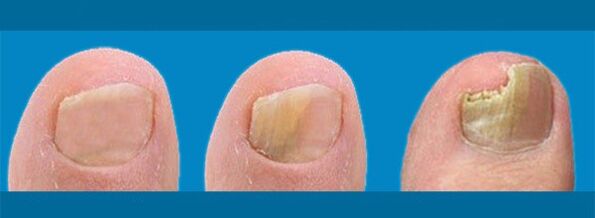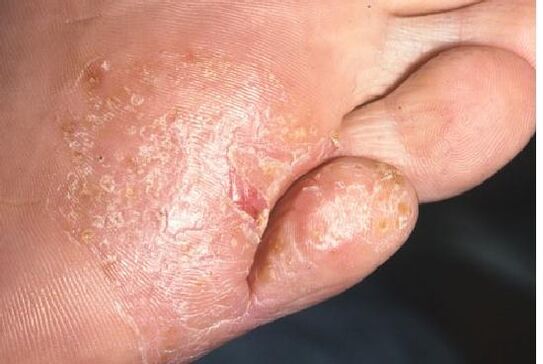In order to detect pathological changes in the condition of the skin of the nails and feet in time and start treatment as soon as possible, it is necessary to know what the fungus of the nail plate looks like. The sooner measures are taken to eliminate the disease, the more likely it is to prevent the destruction of the nail plate and restore its normal appearance. Learn how the fungus manifests itself in different stages and the characteristic features of the course of this disease.
What does onychomycosis look like?

To understand that the nail plates are infected with a fungal infection (onychomycosis), you need to know what healthy nails look like. In a normal condition, the nails are smooth, pale pink colored horny plates, smooth, without bends, bumps and delaminations. Healthy nails are strong and flexible, do not thicken. However, a change in their appearance can signal many pathological processes in the body, so it is necessary to identify specific symptoms characteristic of onychomycosis. They can differ depending on the form of the disease.
- Normotrophic.This is the initial stage of nail fungus. Corneal plates change color, yellowish and white spots and stripes appear on them, as well as an unpleasant odor. This is the initial stage of the disease, so the nail retains its normal thickness and relatively healthy appearance. This stage begins to appear at the end of the incubation period.
- Hypertrophic:the color changes further, the plates begin to thicken and the gloss disappears. Deformation and partial destruction of the plate along the edges can be observed.
- atrophic:the affected nail separates from the nail bed.
Another classification depends on how the nail fungus looks. Depending on which part of the nail is affected by the fungus, it involves dividing the infection into several types:
- Distal.There is delamination and yellowness on the edge of the plate, keratinization of the nail bed. In some cases, the nail may be completely affected and its root (matrix) may also become infected. Thinning of the plate may occur.
- Superficial.The fungus affects the upper part of the horn plate, causing the appearance of white stripes and spots that turn yellow and increase in size over time. They can be easily removed with a scraper. The plate has a hollow structure. This variety is specific: this is how the fungus on the toenails manifests itself.
- Proximal.The fungus forms under the nail, damages the matrix and tissues surrounding the plate. Cuticle rejection may occur. Deep grooves and irregularities appear on the nails.
- General.Nails acquire a grayish-yellow color, become very thick and flaky. The plate is completely or partially destroyed.
Foot fungus

Often, the fungus in the toenails spreads to the skin of the feet. What does the fungus look like on the skin of the feet?
In the first stages, the infection manifests itself in the form of redness and swelling of the skin, the appearance of small cracks.
Often, changes can be observed between the toes and on the heels.
The next symptom of mycosis of the feet is the appearance of spots on the skin, which soon begin to itch and peel. Over time, the size of these spots increases, covering an increasingly large area of the skin in the fungal process. Even if you don't wear shoes, your feet smell bad. If not treated correctly or on time, athlete's foot can develop into a broad form, in which deep cracks are formed on the base of the toes and between them, on the arch of the foot and on the heels. In addition, this stage is characterized by severe separation of the skin.
Diagnosis of fungal nail infections
Anyone away from medicine can suspect a nail or foot fungal infection if they have at least a vague understanding of this disease. However, only a qualified specialist can make an accurate diagnosis and prescribe the appropriate treatment based on the data obtained from the external examination, the patient's survey and the studies of the affected nail under the microscope. In this case, you should contact a dermatologist.
To determine whether a patient actually has a fungal infection, a scraping of the affected nail is taken in the laboratory, and after the material is placed in an alkaline medium, it is examined under a microscope for the presence of fungal mycelium. If such a special structure is detected, the diagnosis will be completely confirmed. Further studies may be ordered to identify the specific type of fungus, which is necessary to choose the most effective drugs against the infection.
Nail fungus not only spoils the appearance of the hands and feet, but can also cause unpleasant consequences, including the complete loss of nail plates and the penetration of fungal infection into the body. In addition, onychomycosis and athlete's foot are contagious diseases, so at the first symptoms, you should see a doctor as soon as possible to protect your loved ones. The incubation period of the fungus can take several weeks, so the disease does not appear immediately. The sooner you seek help from a specialist and accurately diagnose the disease, the sooner the treatment will take place and you will have to spend less money on expensive drugs with antifungal effects.















